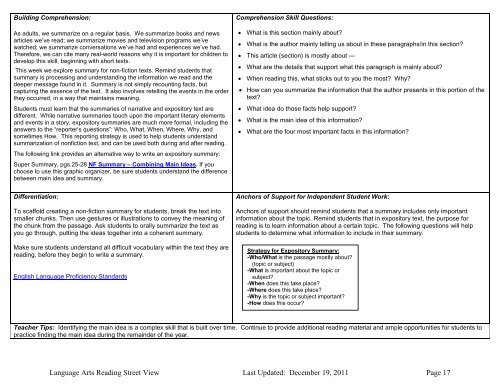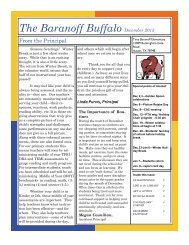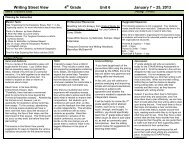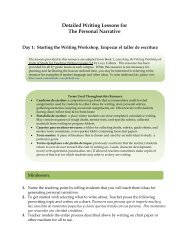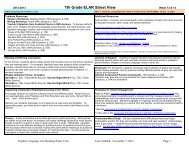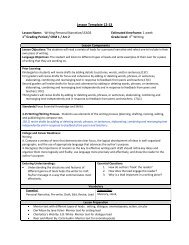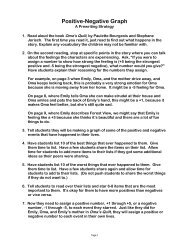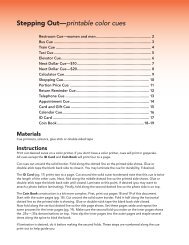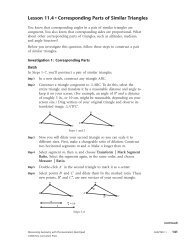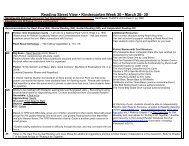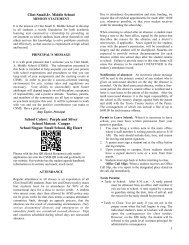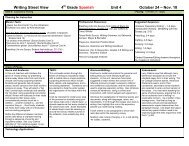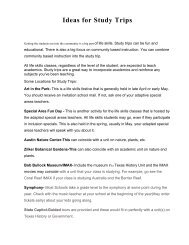Reading street view • 5th grade • week 19 • jan. 5-6
Reading street view • 5th grade • week 19 • jan. 5-6
Reading street view • 5th grade • week 19 • jan. 5-6
Create successful ePaper yourself
Turn your PDF publications into a flip-book with our unique Google optimized e-Paper software.
Building Comprehension:As adults, we summarize on a regular basis. We summarize books and newsarticles we’ve read; we summarize movies and television programs we’vewatched; we summarize conversations we’ve had and experiences we’ve had.Therefore, we can cite many real-world reasons why it is important for children todevelop this skill, beginning with short texts.This <strong>week</strong> we explore summary for non-fiction texts. Remind students thatsummary is processing and understanding the information we read and thedeeper message found in it. Summary is not simply recounting facts, butcapturing the essence of the text. It also involves retelling the events in the orderthey occurred, in a way that maintains meaning.Students must learn that the summaries of narrative and expository text aredifferent. While narrative summaries touch upon the important literary elementsand events in a story, expository summaries are much more formal, including theanswers to the “reporter’s questions”: Who, What, When, Where, Why, andsometimes How. This reporting strategy is used to help students understandsummarization of nonfiction text, and can be used both during and after reading.The following link provides an alternative way to write an expository summary:Super Summary, pgs.25-28 NF Summary – Combining Main Ideas. If youchoose to use this graphic organizer, be sure students understand the differencebetween main idea and summary.Comprehension Skill Questions:• What is this section mainly about?• What is the author mainly telling us about in these paragraphs/in this section?• This article (section) is mostly about —• What are the details that support what this paragraph is mainly about?• When reading this, what sticks out to you the most? Why?• How can you summarize the information that the author presents in this portion of thetext?• What idea do those facts help support?• What is the main idea of this information?• What are the four most important facts in this information?Differentiation:To scaffold creating a non-fiction summary for students, break the text intosmaller chunks. Then use gestures or illustrations to convey the meaning ofthe chunk from the passage. Ask students to orally summarize the text asyou go through, putting the ideas together into a coherent summary.Make sure students understand all difficult vocabulary within the text they arereading, before they begin to write a summary.English Language Proficiency StandardsAnchors of Support for Independent Student Work:Anchors of support should remind students that a summary includes only importantinformation about the topic. Remind students that in expository text, the purpose forreading is to learn information about a certain topic. The following questions will helpstudents to determine what information to include in their summary.Strategy for Expository Summary:-Who/What is the passage mostly about?(topic or subject)-What is important about the topic orsubject?-When does this take place?-Where does this take place?-Why is the topic or subject important?-How does this occur?Teacher Tips: Identifying the main idea is a complex skill that is built over time. Continue to provide additional reading material and ample opportunities for students topractice finding the main idea during the remainder of the year.Language Arts <strong>Reading</strong> Street View Last Updated: December <strong>19</strong>, 2011 Page 17


